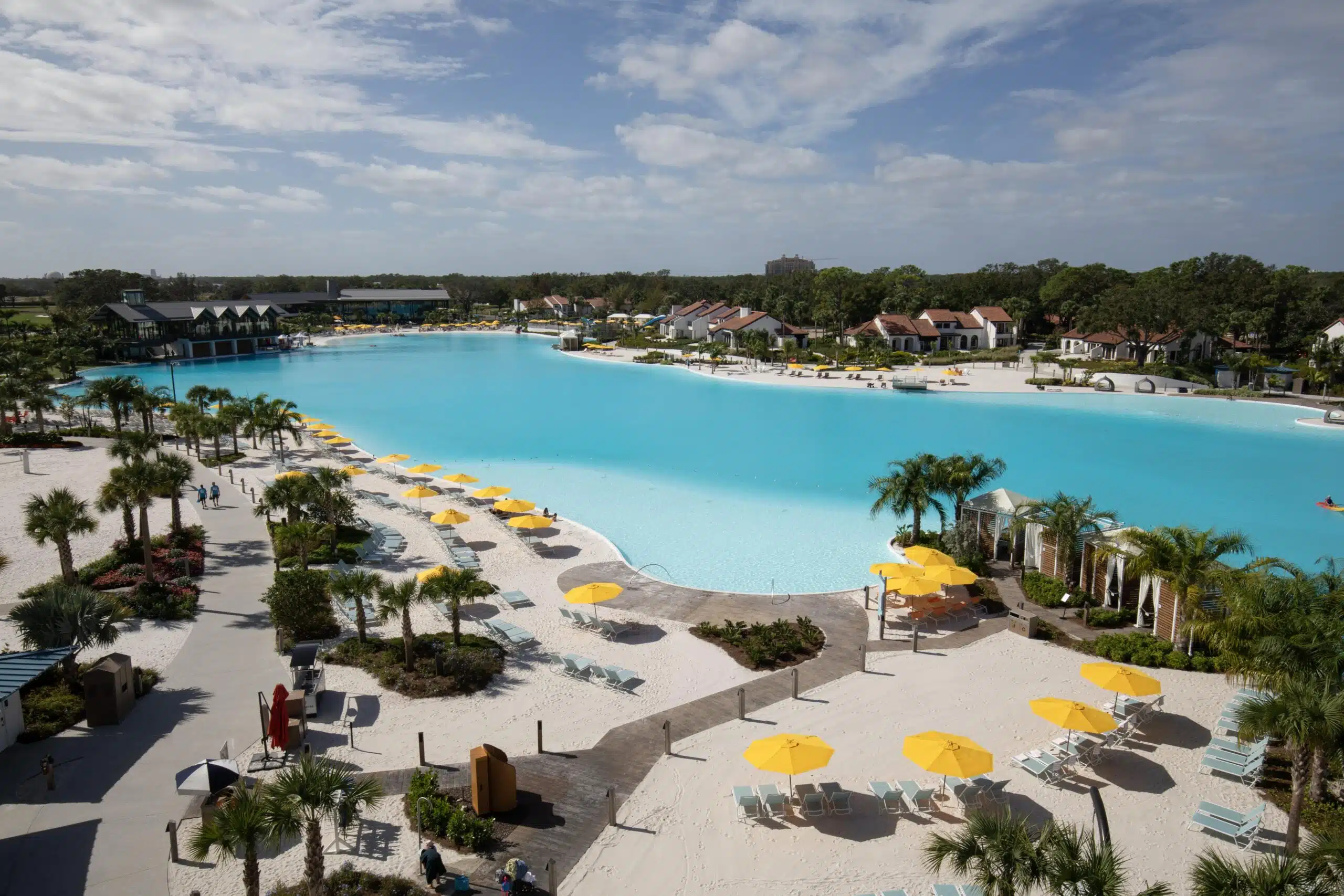- March 12, 2025
- Perspectives, Trending Topics
Markets Driving the Boom in
Man-made Lagoons


Emily Drake
Landscape Architect and Planner

Christopher Falce, PE, LEED AP, CPESC
Civil and Aquatics Engineer
Lagoons powered by Crystal Lagoons® technology are the red-hot trend dotting communities across the US. These man-made, multi-acre lagoons hold tens of millions of gallons of water—serving as inland private beaches, centers of mixed-use developments, entertainment destinations, and amenities that elevate property values.
Residential and commercial communities can take advantage of lagoons’ beauty and functionality, and urban environments can also be transformed with the Public Access Lagoons® business model. Learn more about how their evolving technology makes lagoon amenities appealing to multiple types of developments—no matter the location.
Building Communities with Residential Lagoons
Both single-family communities and multifamily developments have constructed man-made lagoons. People who live inland can now access a beachfront life that otherwise exists hours away. Even man-made lagoons in beachfront developments can offer aquatic activities and consistently calm waters that nearby beaches may not.
This lagoon destination experience can be created away from city centers, reducing initial land costs while targeting key residential growth markets. The implementation of the lagoon increases land values by catalyzing adjacent developments and providing unique amenities. Inland coastal areas are typically far less developed than waterfront properties, and lagoons breathe new life into these often-overlooked parcels of land that enjoy the same climate as nearby beaches.
Man-made lagoons powered by Crystal Lagoons® technology are expanding across the US—including the pictured lagoon at the Evermore Orlando Resort.
In the US, the first man-made lagoon, Epperson, opened in 2018 in Wesley Chapel, Florida. Kimley-Horn served as the engineer of record for the lagoon, completing multidisciplinary work that included civil, structural, mechanical, electrical, and plumbing engineering services. The Epperson project was the first of more than 30 lagoon projects to date for the firm.
With the allure of living near a Crystal Lagoons® amenity, more properties are sold, enabling developers to recover their costs and generate profits in a relatively short period of time. For example, Builder magazine reported a 3.4x increase in sales velocity year over year after Epperson opened. The first artificial lagoon in Texas created a similar response: sales in the Balmoral housing development increased 345% from 2017 to 2018 once the man-made lagoon opened.
Multifamily residences have experienced a similar uplift. Five years ago, SoLé Mia in Miami was the only multifamily development with an artificial lagoon powered by Crystal Lagoons® technology. It leased its nearly 200-unit inventory in fewer than seven weeks, breaking local records. Three-bedroom units that faced the lagoon leased faster and for $300 more on average compared with ocean-facing units.
Destination Lagoons Transform Developments
With more accessible features for the general community, Public Access Lagoons® amenities are not tied to residential developments. One of the newest examples is the Evermore Orlando Resort, which offers a 7.8-acre lagoon surrounded by vacation homes, apartments, a luxury hotel, and other amenities. These hospitality and standalone destinations typically combine a variety of pay-to-play options for water sports, dining, retail, concerts and events, trade shows, corporate meetings, weddings, and more.
Similar to other aquatic amenities, both private developers and municipalities can own and operate lagoons. A year-round thermal beach experience can be achieved through the Eco-Heated Lagoons technology, which naturally warms the lagoon by repurposing waste heat generated from data centers. Properties may also use fire pits, sport courts, heated patio dining, and other gathering areas to create inviting experiences throughout the year.
Planning for Multi-faceted Lagoon Projects
A successful development of any kind includes many aspects of the built environment, such as the design of roadways, walking paths, parking lots, bathrooms, lighting, dining areas, shops, restaurants, and other amenities. The design and construction of a lagoon adds a complexity to the design and requires consultants with multidisciplinary expertise, including permitting, landscape architecture, civil engineering, aquatic design, structural engineering, community master planning, and MEP.
Navigating regulatory issues is often challenging because these types of aquatic amenities are new and may require variances to existing codes or completely novel regulations. Local jurisdictions may be unfamiliar with how to review and permit these projects, and developers may need to plan for additional time and effort to gain approvals from state and local governments. Often these approvals require a comprehensive master plan for the entire project as well as a site plan for the facility detailing the engineering, water quality, and safety aspects of the facility.
Lagoons will continue to expand beyond the Sunbelt states in the coming years to cooler climates. The driving factors of this expansion include advances in technology, market-driven residential expansion outside of city centers, the desire for mixed-use environments that support continued residential growth, and changes to regulations that make the permitting of these projects simpler. The lagoon is a proven catalyst for surrounding residential and commercial development—it is only a matter of time until a lagoon powered by Crystal Lagoons® technology opens in a market near you.
About the Experts

Emily Drake
Emily is a landscape architect and master planner with more than 20 years of experience in US and international markets. She astutely combines her backgrounds in theater and landscape architecture to create unique and desirable destinations that become the hearts of communities. Her broad experience includes visioning, creating design guidelines, and master planning for a variety of destinations, including large-scale master planned communities, mixed-use development sites, aquatic villages, entertainment-based parks, and small urban spaces for both private and public clients. Emily brings a thorough understanding of the process behind developing insightful, humanistic, and timeless projects that support the client’s vision from concept to reality.

Christopher Falce, PE, LEED AP, CPESC
Chris is an engineer and consultant with more than 18 years of experience in managing complex projects throughout the development process. He excels in providing invaluable guidance and support to his clients, earning their trust as a reliable advisor. His portfolio encompasses national and regional development programs, both large- and small-scale mixed-use projects, aquatic amenities, and utility infrastructure initiatives. Chris possesses in-depth knowledge and proficiency in various domains, such as land development, stormwater management, urban planning, water and sewer systems, utility system design, natural gas pipelines, profiling, erosion and sediment control, and project management. His expertise extends to LEED projects and the effective implementation of sustainable design elements.
